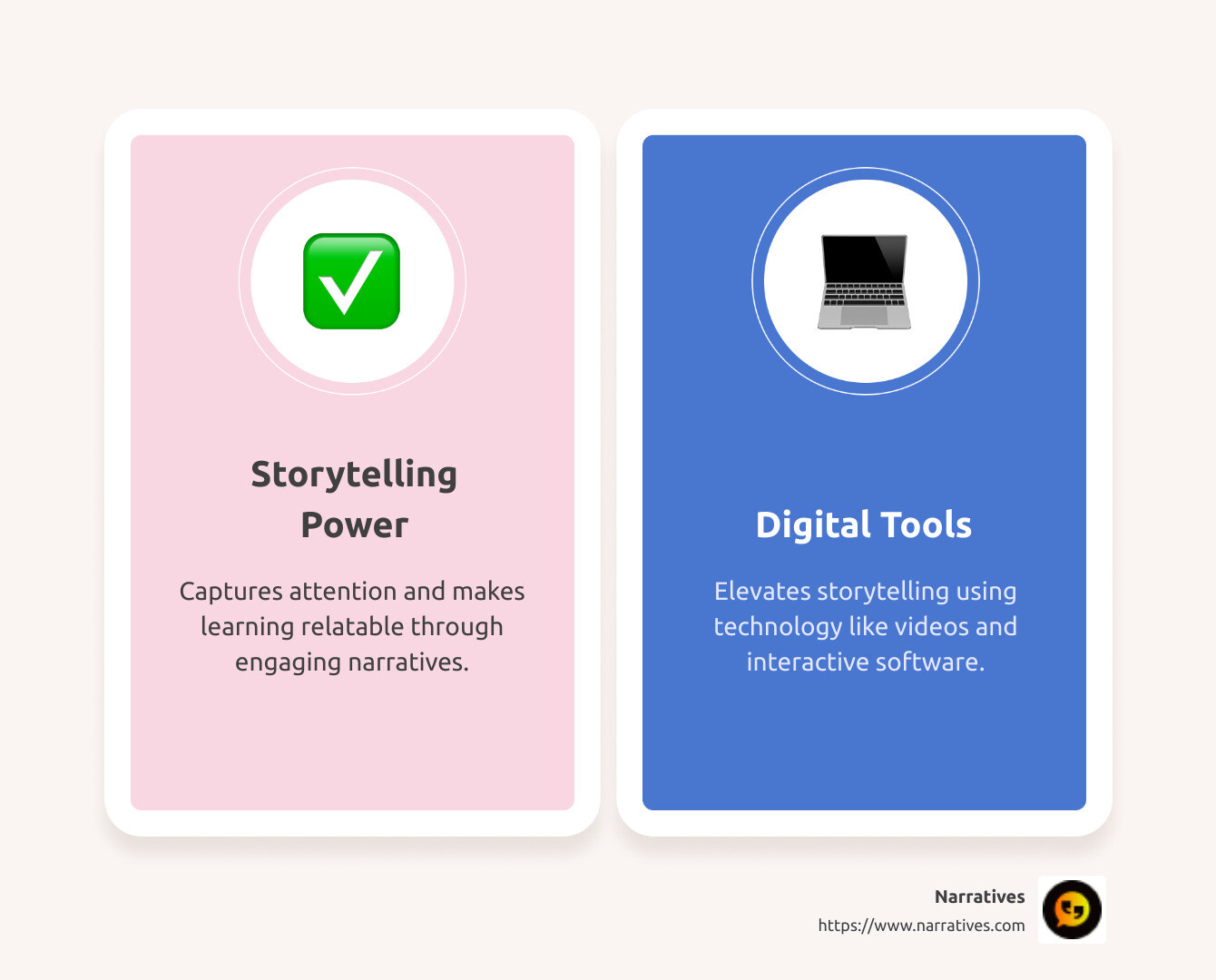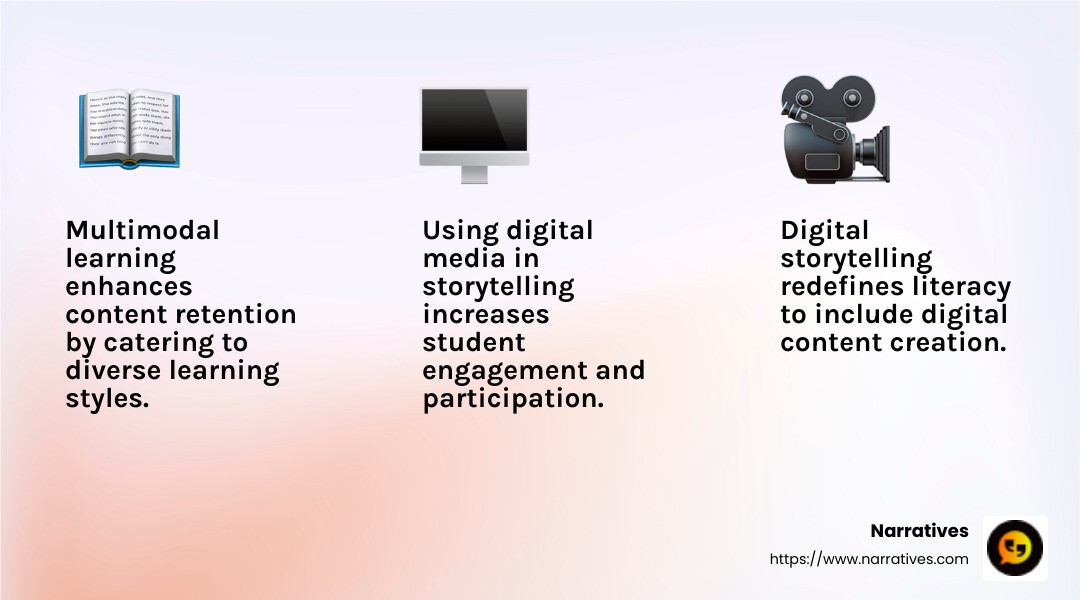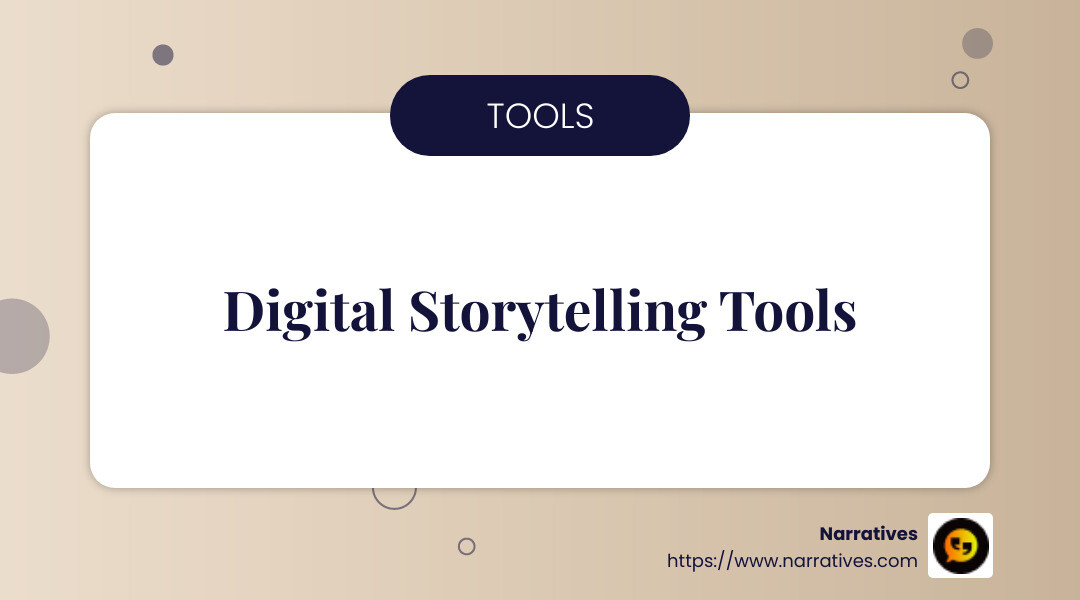Educate and Engage: Digital Storytelling for Teachers

Digital storytelling in education is changing how students learn and engage with the material. By blending narrative, emotion, and technology, teachers can create powerful educational experiences that resonate with students. This innovative approach makes lessons more memorable and meaningful.
Key Points:
- Storytelling Power: Stories capture attention and make learning relatable.
- Emotional Resonance: Emotion improves focus and memory in students.
- Digital Tools: Technology like videos and interactive software lifts storytelling.
The Impact
When students are emotionally invested, they focus better and retain information longer. Digital storytelling empowers educators to deliver content through a compelling narrative structure, using tech tools kids are familiar with.
"I'm mixing storytelling and magic in a show to entertain my young audience... They love it," says GMA, a teacher making storytelling exciting with digital aids.
Digital storytelling also prepares students for today's digital world, where technology is integral. As educators use storytelling to teach, students not only absorb the subject matter but also develop critical thinking and creativity.

Quick digital storytelling in education terms:
- digital storytelling guide for educators
- digital storytelling tools for educators
- digital storytelling examples for students
What is Digital Storytelling in Education?
Benefits of Digital Storytelling
Digital storytelling in education blends traditional storytelling with modern technology, creating a rich, engaging learning experience. This approach leverages multimodal learning, where students engage with content through various forms like text, images, sound, and video. This diversity caters to different learning styles, making education more inclusive and effective.
Multimodal Learning
Multimodal learning allows students to interact with material in multiple ways. For instance, a history lesson might include a video reenactment, a podcast interview, and an interactive timeline. This variety helps students understand complex concepts and retain information better.
Literacy Development
Digital storytelling redefines literacy beyond just reading and writing. It includes understanding and creating digital content. Students learn to express ideas through blogs, videos, and animations, enhancing their communication skills. This broader definition of literacy is crucial in a digital-first world.
Digital Media Engagement
Using digital media in storytelling captures students' attention. Tools like videos, animations, and interactive graphics make lessons dynamic and engaging. Students are more likely to participate and invest in their learning when it feels relevant and exciting.
Authentic Learning Experiences
Digital storytelling emphasizes authenticity. Projects often have real-world applications, motivating students to produce high-quality work. When students know their projects might be shared publicly or used by others, they care more about the outcome.
Literacy Redefinition
Incorporating digital storytelling in education challenges the traditional notion of literacy. As students create and consume digital content, they develop skills in digital literacy, visual literacy, and media literacy. This prepares them for a world where communication is increasingly digital.
Engagement and Authenticity
Engagement is a key benefit of digital storytelling. When students are engaged, they learn better. Authentic storytelling projects make learning relevant and meaningful, reducing the temptation to cheat, as students see the value in their work.
Digital storytelling is a powerful tool in education, combining narrative, technology, and emotion to create a rich, engaging learning environment. It reshapes literacy, making it more relevant to today's digital age, and offers students authentic, memorable learning experiences.
Tools and Techniques for Digital Storytelling
Digital storytelling in education isn't just about telling stories; it's about using the right tools to create engaging and immersive experiences. Let's explore some of the most popular tools and techniques that can transform storytelling in the classroom.
Video Production
Video production is a cornerstone of digital storytelling. It allows students to become filmmakers, crafting narratives using visuals and sound. Programs like iMovie make video editing accessible, even for beginners. Students can create everything from short films to documentaries, enhancing their creativity and technical skills.
Interactive Software
Interactive software takes storytelling to the next level by allowing students to engage with content dynamically. Adobe Slate is a fantastic tool for creating visually stunning stories with minimal effort. It lets students combine text, images, and videos into a cohesive narrative, making learning more interactive and engaging.
Computer Graphics
Computer graphics are essential for adding a visual punch to digital stories. They help illustrate complex ideas and make abstract concepts more tangible. Students can use tools to design graphics that complement their narratives, enhancing both comprehension and retention.
Popular Digital Storytelling Tools
Here's a quick look at some popular tools that educators and students can use:
- iMovie: Perfect for video editing, allowing students to create polished films with ease.
- Adobe Slate: Ideal for crafting interactive stories with a mix of text, images, and videos.
- Flipgrid: A video discussion platform that encourages student engagement through video responses, fostering a sense of community and collaboration.
These tools not only make storytelling easier but also empower students to explore their creativity while learning valuable technical skills.
By integrating these tools into the classroom, educators can create a more dynamic and engaging learning environment. Students become active participants in their education, developing skills that are vital in our digital-first world.
Implementing Digital Storytelling in the Classroom
Quick-Win Digital Storytelling Projects
Digital storytelling in education can transform classrooms into vibrant, creative spaces. By focusing on student engagement and project-based learning, educators can help students develop essential skills while having fun. Let's explore some quick-win projects that can be easily implemented.
Annotated Photography
Annotated photography is a simple yet powerful way to engage students. Here's how it works:
- Take Photos: Students snap pictures related to a topic or theme.
- Add Annotations: They then mark up these images with notes, arrows, or highlights to explain their significance.
This project improves visual literacy and academic vocabulary development. For a more advanced twist, students can record audio descriptions to accompany their images, creating a class digital book. This activity encourages creativity and helps students connect visual and textual information.
Interview an Expert
Interviewing experts is a fantastic way for students to practice public speaking and interpersonal skills. Here's a simple plan:
- Choose a Topic: Students select a subject they are curious about.
- Find an Expert: They reach out to an expert in the field for an interview.
- Conduct the Interview: Students prepare questions and conduct the interview, either in person or virtually.
This project not only builds confidence but also teaches qualitative research methods and the importance of primary sources. For added depth, students can create a podcast by editing their interviews and adding voice-over commentary and music.
Anthology Projects
Anthology projects bring collaboration to the forefront. Students work together to create a collection of stories, essays, or poems on a shared theme. Here's how to get started:
- Select a Theme: The class decides on a central theme or topic.
- Write and Edit: Each student contributes a piece, and then they work together to edit and curate the anthology.
This project emphasizes collaboration, writing, and editing skills. By working as a team, students learn to appreciate diverse perspectives and the power of collective storytelling.
These quick-win projects not only make learning more engaging but also equip students with skills that are essential in today's world. By implementing digital storytelling in the classroom, educators can inspire students to become active participants in their learning journey.
Digital Storytelling for Diverse Learners
Competitive Advantage in Education
Digital storytelling in education is not just a tool for engagement; it's a bridge to empowerment, especially for English Language Learners (ELLs) and students from diverse cultural backgrounds. Here's why it's a game-changer:
ELL Empowerment
For ELL students, digital storytelling is a powerful tool. It allows them to express their thoughts and ideas in ways that go beyond words. By using videos, animations, and graphics, ELLs can communicate complex ideas and improve their language skills without the pressure of perfect grammar.
- Visual and Audio Elements: These help ELLs understand and retain information better, making learning more accessible.
- Confidence Building: Creating digital stories boosts confidence as students see their ideas come to life.
Cultural Literacy and Communication Skills
Digital storytelling fosters cultural literacy by encouraging students to share their own stories and learn about others. It opens up dialogues about different cultures, traditions, and perspectives.
- Cultural Exchange: Students can create stories that reflect their heritage, promoting understanding and empathy among peers.
- Communication Skills: Through story creation, students practice organizing thoughts, asking questions, and constructing narratives.
Job-Market Edge and Tech Proficiency
In today's job market, having skills in digital storytelling provides a competitive edge. Employers value candidates who can leverage technology to communicate effectively and creatively.
- Tech Proficiency: Familiarity with digital tools like iMovie, Adobe Slate, and Flipgrid is a plus in many fields.
- Dynamic Curriculum: Schools that incorporate digital storytelling offer a curriculum that mirrors the digital world students live in, preparing them for future careers.
By integrating digital storytelling into education, schools not only improve student learning but also equip them with vital skills for the future. This approach ensures that all students, regardless of background, can thrive in an increasingly digital world.
Frequently Asked Questions about Digital Storytelling in Education
How does digital storytelling support student learning?
Digital storytelling in education is a powerful way to support student learning by making lessons more engaging and memorable. Here's how:
Emotional Connection: Stories evoke emotions, which helps in capturing students' attention and enhancing memory retention. When students are emotionally invested, they are more likely to remember the lesson.
Active Participation: Students become co-creators of their learning experience. They use digital tools to produce stories, which encourages critical thinking and problem-solving.
Multimodal Learning: By combining text, images, video, and audio, digital storytelling caters to different learning styles. This flexibility allows students to engage with content in a way that suits them best.
What are the types of digital storytelling?
Digital storytelling can take many forms, each offering unique ways to convey information and engage students:
Video Stories: Using platforms like iMovie, students can create short films or documentaries that bring their ideas to life.
Podcasts: Audio storytelling allows students to explore topics through interviews, discussions, and narratives, enhancing their listening and speaking skills.
Interactive Presentations: Tools like Adobe Slate enable students to create dynamic presentations that incorporate text, images, and links for a more interactive experience.
Animation and Graphics: Software for creating animations and graphics can help students illustrate complex concepts in a visually appealing way.
Why is digital storytelling important in education?
Digital storytelling is crucial in modern education for several reasons:
Engagement and Motivation: It turns passive learning into an active process, keeping students motivated and invested in their education.
Authentic Learning: Projects are often shared beyond the classroom, giving students a real audience and a sense of purpose.
Skill Development: Students gain valuable skills in technology, communication, and creativity, all of which are essential in today's digital world.
Cultural Understanding: By sharing and listening to diverse stories, students develop empathy and a deeper understanding of different cultures.
Digital storytelling is not just about telling stories; it's about making education relevant, dynamic, and inclusive. This approach prepares students for the future by equipping them with the skills they need to succeed in a digital age.
Conclusion
Narratives are more than just stories. They are powerful tools that shape our understanding of the world. In education, narratives can transform learning experiences, making them more impactful and memorable. Through digital storytelling, educators can harness the power of narratives to engage students and foster a deeper connection to the material.
Social impact is at the heart of digital storytelling. By sharing stories that resonate emotionally, educators can inspire students to think critically about societal issues and encourage them to become active participants in their communities. This approach not only improves learning but also empowers students to make a difference in the world around them.
Community-driven storytelling takes this a step further by involving students, teachers, and communities in the storytelling process. When students share their stories, they contribute to a collective narrative that reflects diverse perspectives and experiences. This inclusivity fosters a sense of belonging and builds a supportive learning environment where every voice is heard.
At Narratives, we believe in the power of storytelling to drive change and create meaningful connections. Our mission is to lift underrepresented voices through high-quality, emotionally resonant multimedia content. By partnering with non-profits and purpose-driven organizations, we help share impactful stories that inspire action and build trust.
Explore how Narratives can support your storytelling journey and help your organization make a lasting impact. Learn more about our services here.




